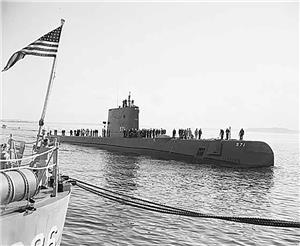On June 3, 1958, the USS Nautilus, the world's first nuclear submarine, visits Everett and Seattle. In Seattle, crewmen dressed in civilian clothing secretly buy 140 quarts of the automotive product Bar's Leaks (originally identified as Stop Leak -- see comment in Sources below) to repair a leaking condenser system. The Nautilus is enroute to the North Pole on a Top Secret mission to cross the North Pole submerged.
The Nautilus was commissioned in 1954 and featured a nuclear power plant instead of the usual combination of diesel engines and battery-powered electric motors. The Nautilus was capable of remaining underwater without the necessity of surfacing to recharge the batteries and without refueling. U.S. Navy leaders realized the military importance of the Arctic Ocean in the Cold War. The Arctic is covered with ice year round, but navigation under the ice was a possibility. The Nautilus was ordered to transit the North Pole underwater in a Top Secret mission dubbed Operation Sunshine.
On June 2, 1958, the Nautilus arrived in Everett and spent the night there. The following day, with a load of dignitaries and journalists, the submarine ran to Seattle and docked at Pier 91. A leaking condenser unit threatened the secret mission to the North Pole, but security concerns and time precluded repairs through the usual channels. Experts hit on the idea of using Bar's Leaks, an automotive stop-leak product developed for leaking radiators.
Commander William Anderson ordered crewmen to change into civilian clothing. The men fanned out across Seattle in taxicabs to buy cans of Bar's Leaks at local service stations.
The sailors in mufti returned with 140 quarts of Bar's Leaks, half of which was poured into the condenser. The leak stopped.
Just after midnight on June 9, 1958, the Nautilus cast off and headed north. While running on the surface in Puget Sound, the crew painted out the large numbers on the sail (conning tower) and the bow to conceal the sub's identity.
In the Chukchi Sea, Commander Anderson ran into heavy ice and a shallow bottom (at the time the floor of the Arctic was not mapped), and broke off the mission. Later in the summer, the Nautilus successfully crossed the Arctic, completely under water.
The event received worldwide publicity and changed the complexion of the Cold War. The crew was celebrated with a ticker-tape parade in New York City and President Dwight D. Eisenhower awarded the Nautilus the Presidential Unit Citation. Commander Anderson revealed the Seattle episode in his book Nautilus 90 North, published the following year.
The condenser unit aboard the Nautilus never leaked again.

